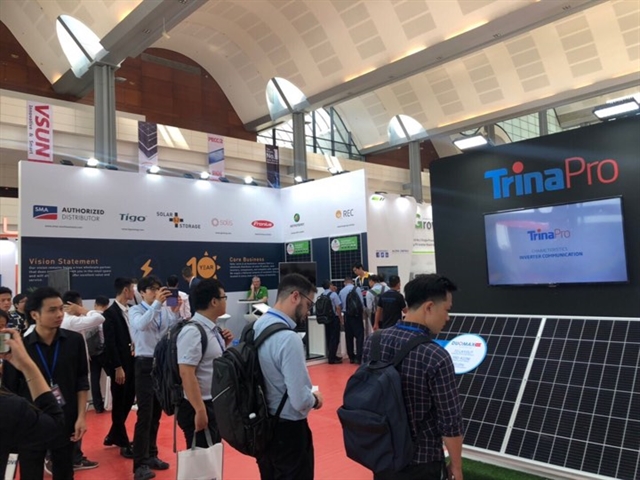 Economy
Economy

Project developers and government agencies should think about how to maximise the use of renewable energies.

|
| Visitors at the Vietnam Solar Power Expo 2019 held on September 25-26. - Photo Vietnam Solar Power Expo |
HÀ NỘI — Renewable power facilities should be built in localities where strong consumption exists and electricity transmission is direct to avoid power loss, business leaders said on Wednesday.
Rising demand for renewable energy in Việt Nam has sometimes overloaded the national power grid as power is connected to the grid but not distributed immediately to consumers.
Phan Ngọc Ánh, Director of Alena Energy Co Ltd, said Việt Nam has its own 500kV grid but the expansion of the grid network cannot meet the development of renewable energy.
Renewable energy facilities are often built in areas where no industrial zones exist, which is a big source of output consumption, he said.
“Renewable energy sources, especially solar power, should focus on industrial hubs so power is consumed constantly,” he told Việt Nam News at the Vietnam Solar Power Expo 2019.
In addition, the Government should construct the grid that connects power sources to the nearest consumers to make sure power is transmitted and used efficiently, he said.
“Power storage is not a usual thing for solar farms because of high expenses, which will affect the projects’ operation.”
Project developers and government agencies should think about how to maximise the use of renewable energies, not lower the prices to boost consumption, he suggested.
Sharing the view, Vũ Thắng, Vietnam Country Manager of Sungrow Power Supply Co Ltd, said investors must be smart when choosing the location of their projects.
Renewable energy projects should be executed in areas that are not too distant from consumers, he said, adding investors must be able to optimise their resources.
Regarding the feed-in-tariff (FiT) rate, which was 9.35 US cents as of June 30, 2019, both executives said the rate is quite attractive to investors because it ensures developers are profitable when building solar power projects in the country.
Bidding will make the price more beneficial to the national power group Electricity of Vietnam, given that the consumption of rooftop solar power is guaranteed for the next 20 years, Thắng said.
The Government must improve the transparency of its power purchase power agreements (PPAs) and contract expirations so that renewable energy developers, mostly private firms, are able to implement their projects quickly, Ánh said.
“Building a solar power plant is fast compared to the policy making process. If the policy making is slower than plant construction, the development of the industry will lag behind its potential,” Ánh said.
Việt Nam’s renewable energy industry is increasingly getting more attractive to investors.
Vincent Chan, international sales’ regional manager at Clenergy (Xiamen) Technology Co Ltd, is confident that there is still room for the growth of renewable energies in Việt Nam.
“The Vietnamese Government has done very well and it will continue having very good policies,” he said.
What will benefit the industry is less taxes imposed on imported components and devices used for solar power development, which will encourage the growth of solar projects in Việt Nam and lower the cost of construction for the projects, he added.
Tô Ngọc Sơn, deputy director of Asia-Africa Markets Department at the Ministry of Industry and Trade, said at the two-day expo there are 82 solar power projects across the country with total capacity of 4,460MW, accounting for 10 per cent of total power production. Thirteen other projects are being completed and plan to begin operations in late 2019, adding 630MW to the country’s total output. — VNS




